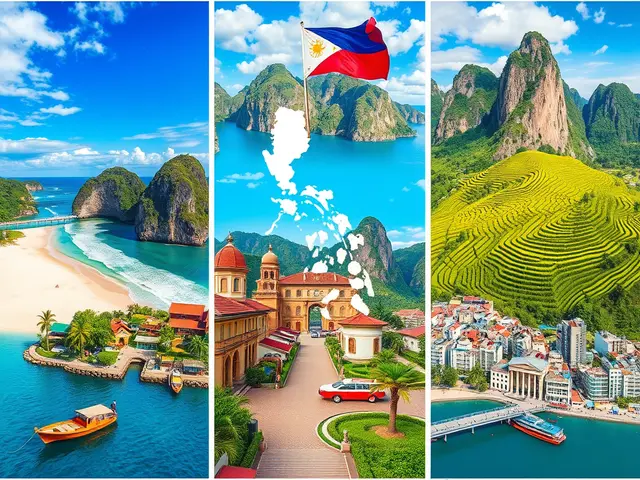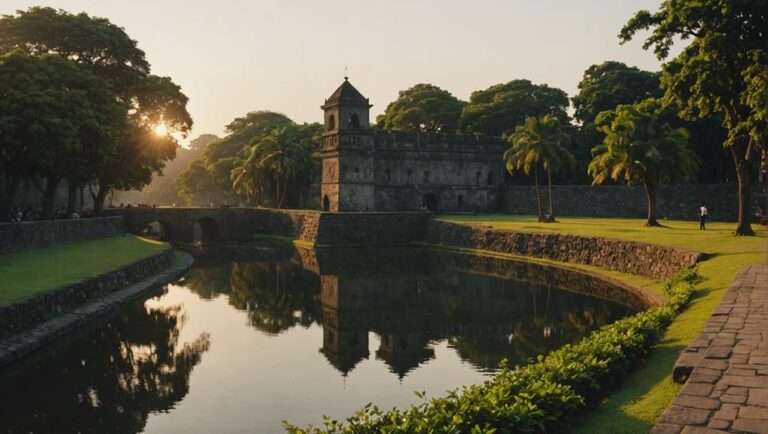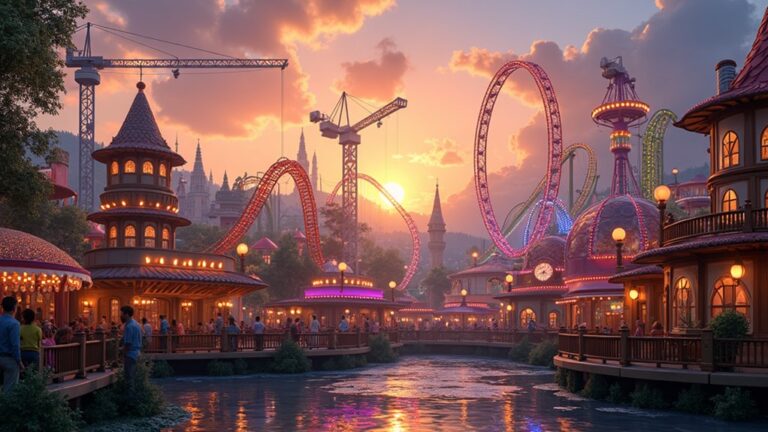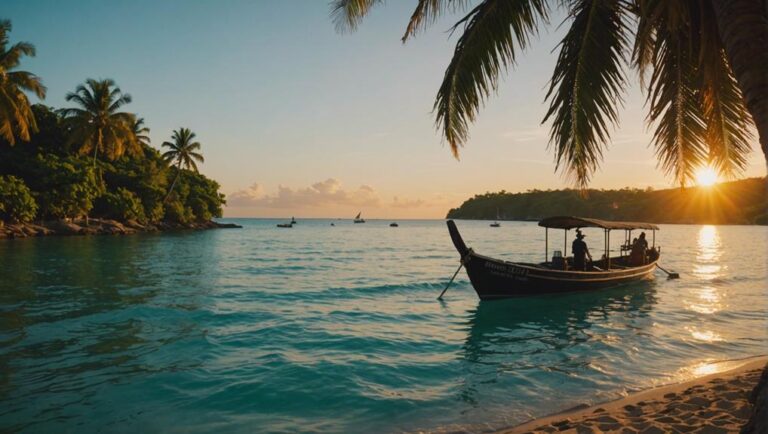Intramuros Manila Philippines

Intramuros, Manila’s walled city, invites you to step into centuries of history. Stroll along its 20-foot-thick walls and admire Spanish colonial military architecture. Explore Fort Santiago and learn about national hero José Rizal’s final days there. Visit the awe-inspiring Manila Cathedral and the resilient San Agustin Church.
Choose a leisurely pedicab or nostalgic kalesa to navigate the narrow, picturesque streets. Discover hidden gems in colonial-era buildings and stroll through iconic public squares like Plaza de Roma.
Intramuros blends the old with the new, preserving its rich history while embracing contemporary life. Embrace the journey ahead to uncover more about this captivating place.
Key Takeaways
- Intramuros, Manila’s historic walled city, dates back to Spanish rule in 1571.
- Key landmarks include Manila Cathedral, San Agustin Church, and Fort Santiago.
- Visitors can explore by walking, pedicab, or kalesa.
- Ongoing restoration and urban revitalization maintain its historical charm.
- Guided tours offer insights into Intramuros’ rich cultural and historical significance.
Intramuros Manila Philippines At A Glance
| Category | Details |
|---|---|
| Facts | Area: 0.67 square kilometers (67 hectares) |
| Population: Approximately 6,000 residents (as of recent estimates) | |
| Established: 1571 by Spanish conquistador Miguel López de Legazpi | |
| Notable for: Being the oldest district and historic core of Manila | |
| History | Pre-Spanish Era: The site was originally a settlement called Maynilad, ruled by Rajahs |
| Spanish Era: Became the center of political, religious, and military power during Spanish rule | |
| Fortified City: Enclosed by massive stone walls and moats to protect against invaders | |
| World War II: Suffered heavy damage during the Battle of Manila in 1945 | |
| Post-War Reconstruction: Significant efforts have been made to restore and preserve the area | |
| Location | Coordinates: 14.5906° N, 120.9739° E |
| Region: Metro Manila | |
| Boundaries: Surrounded by the Pasig River to the north, Manila Bay to the west, and Ermita to the south | |
| Accessibility: Accessible via major roads and public transportation | |
| Landmarks | Fort Santiago: A citadel first built by Spanish conquistador Miguel López de Legazpi |
| Manila Cathedral: Officially the Minor Basilica of the Immaculate Conception, it is the premier church of the Philippines | |
| San Agustin Church: A UNESCO World Heritage Site, known for its Baroque architecture | |
| Plaza de Roma: Central square in front of the Manila Cathedral, historically the center of the city’s social life | |
| Casa Manila: A museum depicting colonial lifestyle, part of the Plaza San Luis Complex | |
| Baluarte de San Diego: One of the oldest stone fortifications in Intramuros | |
| Rizal Shrine: A museum dedicated to José Rizal, located within Fort Santiago | |
| Puerta Real Gardens: Historic gardens near the southern entrance of Intramuros | |
| Museo de Intramuros: Showcases ecclesiastical art from the Spanish colonial period |
Historical Overview
Intramuros, the historic walled city of Manila, has a rich and multifaceted history that spans several significant periods, each leaving an indelible mark on its development and cultural landscape. Before Spanish rule, the area thrived under pre-Hispanic influences, serving as a strategic trading hub with various regions across Asia.
🏰 The name “Intramuros” means “within the walls” in Latin, referring to the massive stone walls and fortifications that surrounded the original city.
You’ll find that the Spanish period, starting in 1571, fundamentally transformed Intramuros. The Spanish established it as the capital of their new colony, constructing imposing walls and Baroque-style churches that still stand as proof of their rule.
When the Americans took over in 1898, Intramuros saw significant changes. They introduced urban development projects and educational institutions, reshaping the city’s infrastructure. However, World War II brought devastation. The Battle of Manila in 1945 left Intramuros in ruins, with its grand structures reduced to rubble.
Postwar reconstruction efforts aimed to restore the walled city’s former glory, focusing on the preservation of defence structures and significant monuments. This period saw the revitalization of Intramuros’ cultural heritage, as well as the establishment of educational institutions that continue to shape its identity today.
Walking through Intramuros, you’ll notice the careful preservation of monuments and the thoughtful urban development that has allowed the city to retain its historical essence while adapting to modern needs. These actions guarantee that Intramuros remains a living museum, where the past is meticulously preserved and celebrated.
Architectural Features
Among the most striking elements you’ll encounter within the historic walls are the intricate bastions, baluartes, and other defence structures that exemplify the strategic military architecture of the Spanish colonial period. These fortifications not only highlight the architectural styles of the era but also underscore the Spanish influence on Filipino cultural heritage.
As you walk along the 20-foot-thick walls, you’ll appreciate the preservation techniques employed to maintain their original grandeur. These methods are vital in combating the wear and tear brought by time and urban development.
The bastions, such as Baluarte de San Diego, showcase the blend of Renaissance and Baroque styles, which were prevalent during the Spanish rule. The detailed stonework and strategic placements of these structures were designed to withstand sieges and invasions, offering a glimpse into the military ingenuity of the time.
Restoration challenges are an important aspect of maintaining Intramuros’ historical integrity. The post-World War II reconstruction faced hurdles, from sourcing authentic materials to addressing modern urban development pressures. Efforts to restore period houses, gates, and pentagonal walls often require balancing historical accuracy with contemporary needs.
The cultural significance of Intramuros can’t be overstated. It serves as a living museum, reflecting centuries of Philippine history and Spanish colonial influence. Landmarks like Manila Cathedral and San Agustin Church aren’t just architectural marvels but also symbols of enduring faith and resilience.
🏯 Intramuros is the oldest district and historic core of Manila, founded by the Spaniards in 1571 as the capital of their colonial empire in the Philippines.
Contemporary Intramuros
Today, you can witness how Intramuros stands as a vibrant blend of historical reverence and contemporary energy, offering a unique window into Manila’s past and its evolving present. Intramuros today is a proof of both modern development and cultural preservation. The walled city has seen significant urban revitalization efforts, with restored gates and buildings that reflect its storied history while accommodating modern needs.
Walking through Intramuros, you’ll notice a harmonious mix of old and new. The cobblestone streets and colonial architecture coexist with contemporary establishments like cafes, restaurants, and educational institutions. These developments don’t overshadow the cultural heritage; instead, they enhance it, making the area more accessible and engaging for both locals and tourists.
Community engagement plays a significant role in Intramuros today. Locals participate in various activities aimed at promoting the historical and cultural significance of the area. From guided tours to cultural festivals, these initiatives make sure that the rich legacy of Intramuros isn’t only preserved but also celebrated. The Intramuros Administration has been instrumental in these efforts, balancing preservation with the demands of modern urban life.
🗿 The iconic San Agustin Church, located within Intramuros, is one of the oldest churches in the Philippines, dating back to 1607.
Moreover, the ongoing projects for urban revitalization are aimed at making Intramuros more visitor-friendly. Improvements in infrastructure, green spaces, and public amenities are part of this initiative. These enhancements make it easier for visitors to explore and appreciate the historical context while enjoying modern comforts.
Monuments and Structures
As you meander through the lively streets of contemporary Intramuros, your journey inevitably brings you face-to-face with the awe-inspiring monuments and structures that stand as silent narrators of its storied past. Each corner you turn reveals a blend of historical authenticity and architectural significance, painstakingly preserved despite the ravages of time and war.
- Among the most striking examples is the Manila Cathedral, a beacon of faith and resilience. Its post-war reconstruction showcases a seamless blend of old and new, honouring its original Gothic-Romanesque design while incorporating modern materials.
- Nearby, the San Agustin Church, a UNESCO World Heritage site, stands as proof of enduring devotion, its intricate baroque details are a marvel to behold.
- However, maintaining these structures comes with significant preservation challenges. The tropical climate, urban pollution, and the sheer passage of time require constant vigilance and care. The relocation of monuments like the Queen Isabel II Statue, which was moved to a more prominent location, highlights efforts to enhance both visibility and educational value.
- Fort Santiago, another iconic structure, bears the scars of war and liberation. Its restoration efforts aim to maintain historical authenticity, offering visitors a glimpse into its storied past while ensuring safety and structural integrity.
- The walls and gates of Intramuros, initially built to repel invaders, now stand as guardians of history, painstakingly restored to reflect their former glory.
🌉 The iconic Jones Bridge, a double-deck bridge that spans the Pasig River, was constructed during the American colonial period and connected Intramuros to the rest of Manila.
Getting Around Intramuros
Exploring the vibrant streets of Intramuros is an adventure in itself, offering a unique blend of historical charm and modern conveniences. As you navigate this historic walled city, you’ll find various transportation options and impressive accessibility. Start your journey by choosing how you’d like to get around: whether it’s hopping on a traditional pedicab or opting for a more nostalgic ride in a kalesa, these modes of transport offer a delightful way to see the sights.
For those who prefer exploring on foot, Intramuros is a walker’s paradise. The narrow streets, lined with colonial-era buildings, invite you to wander and discover hidden gems at your own pace. Walking gives you the freedom to stop by public squares and engage in leisure activities, from people-watching to enjoying street performances. The iconic Plaza de Roma, for instance, is perfect for a leisurely stroll or a quick rest.
Navigating traffic in Intramuros can be a bit of a challenge, especially during peak hours. However, the slow pace of vehicles often adds to the charm, allowing you to take in the surroundings without feeling rushed.
Remember to stay hydrated, especially if you’re visiting during the hotter months. Carry a bottle of water with you, and take breaks in the shade whenever possible.
Exploring Sights and Activities
You’ll find an array of fascinating sights and activities in Intramuros, each offering a unique glimpse into Manila’s rich historical fabric.
- Start your exploration at Fort Santiago, a fortress brimming with cultural heritage and historical significance. As you wander, you’ll uncover stories of heroes and martyrs, particularly the revered national hero, José Rizal.
- Next, visit the majestic Manila Cathedral and San Agustin Church. These architectural marvels aren’t just places of worship but also repositories of history. Their intricate designs and resilient structures speak volumes about the Spanish colonial era.
- For a stroll, head to the public squares like Plaza de Roma. Here, you can soak in the ambience, watch locals go about their day, and perhaps catch a cultural performance. These squares are perfect spots to rest and reflect on the historical significance of your surroundings.
- Joining day tours can enrich your experience. Guided tours provide in-depth narratives about the sites, ensuring you don’t miss out on any intriguing details. Whether it’s a walking tour or a ride in a traditional kalesa, these tours weave together the past and present seamlessly.
- Don’t forget to explore the leisure activities that Intramuros offers. From biking around the walled city to visiting museums like Casa Manila and the Bahay Tsinoy, there’s something for everyone. These activities not only entertain but also educate, deepening your appreciation for Manila’s cultural heritage.
Interesting Facts About Intramuros Manila
- 🏛️ The Ayuntamiento (City Hall) of Manila, built in the 19th century, is located within Intramuros and features a unique blend of neo-classical and Spanish-Filipino architectural styles.
- 🏔️ The Baluarte de San Diego, a bastion located within Intramuros, offers a panoramic view of the city and the nearby Rizal Park, a popular tourist destination.
- 🌺 The Puerta Real Gardens, located near the entrance of Intramuros, feature beautifully landscaped gardens and offer a peaceful respite from the bustling city.
- 🎨 The Intramuros district is home to several art galleries and museums, including the Museo de Intramuros, which showcases the rich cultural heritage of the Philippines.
- 🍽️ The district is also known for its vibrant culinary scene, with many restaurants and cafes offering traditional Filipino cuisine as well as international fare.
- 🌙 At night, the walls and fortifications of Intramuros are beautifully illuminated, creating a stunning and atmospheric setting for evening strolls or events.
What are the Top Tourist Attractions in the Philippines?
The Tubbataha Reef Philippines is a must-visit for diving enthusiasts. Its vibrant coral reefs and diverse marine life make it a top tourist attraction in the country. Aside from diving, visitors can also enjoy beautiful beaches, historical sites like the Banaue Rice Terraces, and the stunning landscapes of Palawan and Boracay.
Frequently Asked Questions
What Are the Best Times of the Year to Visit Intramuros?
The best times to visit are during the dry season from December to May. You’ll enjoy pleasant weather patterns and fewer tourist crowds. Off-peak benefits include fewer lines, and seasonal attractions shine. Climate tips: pack light clothing.
Are There Any Festivals or Events Held in Intramuros?
You’ll find vibrant festivals featuring cultural performances, historical reenactments, and art exhibitions. Traditional parades and night markets add to the lively atmosphere, making your visit unforgettable. Don’t miss these unique events for a richer experience!
What Are the Accommodation Options Near Intramuros?
You’ve got plenty of accommodation options nearby, including boutique hotels, budget hostels, heritage inns, luxury resorts, and family lodgings. Each offers unique amenities and experiences, ensuring your stay is comfortable and memorable.
How Can Visitors Stay Hydrated and Comfortable in Intramuros?
To guarantee hydration and comfort, utilize water stations and hydration packs. Carry cooling towels and seek shade spots. Refreshment stalls offer drinks to keep you cool. These tips guarantee you enjoy your visit without discomfort.
What Are the Dining Options in Intramuros?
You’ll find diverse dining options, from street food and cafeteria choices to local cuisine and gourmet restaurants. Enjoy the dining ambiance as you explore everything from casual bites to exquisite meals, catering to all tastes.
Conclusion
Intramuros is a captivating journey through centuries of Philippine history. From the imposing fortifications to the centuries-old churches, every structure tells a story of resilience and cultural significance.
Exploring this walled city allows you to experience a harmonious blend of the past and present. Whether strolling along the cobblestone streets, joining a guided tour, or savoring local cuisine, Intramuros ensures an enriching and unforgettable experience of Manila’s storied heritage.





